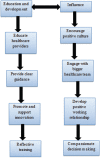Significance of Ongoing Training and Professional Development in Optimizing Healthcare-associated Infection Prevention and Control
- PMID: 39100741
- PMCID: PMC11296567
- DOI: 10.4103/jmss.jmss_37_23
Significance of Ongoing Training and Professional Development in Optimizing Healthcare-associated Infection Prevention and Control
Abstract
The employees who work in infection prevention and control (IPC) are very important in the field of health-care because they are committed to protecting patients, staff, and visitors from the risk of acquiring infections while in the hospital. The complexity of infection control in hospitals is alwaysgrowing in tandem with the rapid developments that are being made in medical technology andpractices. IPC personnel are required to maintain vigilance and continually improve their monitoringof the entire health-care process due to the ongoing development of IPC guidelines and regulations, the fluctuating infection risks, and the emergence of new infectious diseases. As a result, individuals involved in the prevention and control of infections in health-care settings absolutely need to participate in continual training and professional development. This reviewemphasizes the need of relevant professionals to engage in ongoing training and professional development to maintain their skills in the area of healthcare-associated infection control and prevention. Personnel working in IPC may more effectively react to newly discovered health risks andmake certain that hospital infection (HI) management gets the appropriate attention if they have atimely and in-depth awareness of best practices. They are better able to maintain their composure, react correctly, and deliver the most effective infection control and prevention techniques for the health-care system, all while increasing awareness about the significance of effective HI management.
Keywords: Healthcare-associated infection; ongoing training; professional development.
Copyright: © 2024 Journal of Medical Signals & Sensors.
Conflict of interest statement
There are no conflicts of interest.
Figures
Similar articles
-
Barriers and facilitators to healthcare workers' adherence with infection prevention and control (IPC) guidelines for respiratory infectious diseases: a rapid qualitative evidence synthesis.Cochrane Database Syst Rev. 2020 Apr 21;4(4):CD013582. doi: 10.1002/14651858.CD013582. Cochrane Database Syst Rev. 2020. PMID: 32315451 Free PMC article.
-
Risks and challenges in COVID-19 infection prevention and control in a hospital setting: Perspectives of healthcare workers in Thailand.PLoS One. 2023 Dec 19;18(12):e0267996. doi: 10.1371/journal.pone.0267996. eCollection 2023. PLoS One. 2023. PMID: 38113209 Free PMC article.
-
Critical Care Network in the State of Qatar.Qatar Med J. 2019 Nov 7;2019(2):2. doi: 10.5339/qmj.2019.qccc.2. eCollection 2019. Qatar Med J. 2019. PMID: 31763205 Free PMC article.
-
The politics and ethics of hospital infection prevention and control: a qualitative case study of senior clinicians' perceptions of professional and cultural factors that influence doctors' attitudes and practices in a large Australian hospital.BMC Health Serv Res. 2019 Apr 2;19(1):212. doi: 10.1186/s12913-019-4044-y. BMC Health Serv Res. 2019. PMID: 30940153 Free PMC article.
-
Use of "Social Media"-an Option for Spreading Awareness in Infection Prevention.Curr Treat Options Infect Dis. 2021;13(1):14-31. doi: 10.1007/s40506-020-00244-3. Epub 2021 Jan 23. Curr Treat Options Infect Dis. 2021. PMID: 33519303 Free PMC article. Review.
Cited by
-
A NLP analysis of digital demand for healthcare jobs in China.Sci Rep. 2025 Apr 25;15(1):14518. doi: 10.1038/s41598-025-98552-5. Sci Rep. 2025. PMID: 40281033 Free PMC article.
-
Knowledge, Attitudes, and Practices of Infection Prevention and Control Nurses in Public Hospitals in the Limpopo Province: A Qualitative Study.Int J Environ Res Public Health. 2025 Jan 16;22(1):116. doi: 10.3390/ijerph22010116. Int J Environ Res Public Health. 2025. PMID: 39857569 Free PMC article.
-
A multimedia tool for infection prevention and control practices in the intensive care unit: a participatory interventional before-after study.Infect Prev Pract. 2024 Dec 5;7(1):100423. doi: 10.1016/j.infpip.2024.100423. eCollection 2025 Mar. Infect Prev Pract. 2024. PMID: 39807390 Free PMC article.
-
Improving Preoperative Care in Pakistan: An Evaluation of Pre-anesthetic Record Completeness and Documentation Practices.Cureus. 2025 Feb 27;17(2):e79761. doi: 10.7759/cureus.79761. eCollection 2025 Feb. Cureus. 2025. PMID: 40161154 Free PMC article.
-
Striving for zero traditional and non-traditional healthcare-associated infections (HAI): a target, vision, or philosophy.Antimicrob Steward Healthc Epidemiol. 2025 Jun 30;5(1):e146. doi: 10.1017/ash.2025.10031. eCollection 2025. Antimicrob Steward Healthc Epidemiol. 2025. PMID: 40612460 Free PMC article. Review.
References
-
- Khan HA, Ahmad A, Mehboob R. Nosocomial infections and their control strategies. Asian Pac J Trop Biomed. 2015;5:509–14.
-
- Boev C, Kiss E. Hospital-acquired infections: Current trends and prevention. Crit Care Nurs Clin North Am. 2017;29:51–65. - PubMed
-
- Sikora A, Zahra F. In: StatPearls [Internet] Treasure Island (FL): StatPearls Publishing; 2023. Nosocomial Infections 2023.
-
- World Health Organization. Global Report on Infection Prevention and Control. Geneva: World Health Organization; 2022.
Publication types
LinkOut - more resources
Full Text Sources
Research Materials




